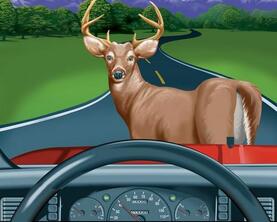"I'VE HIT A DEER WITH MY CAR! WHAT SHOULD I DO NOW?”

This is unfortunately a common phrase, especially in some parts of the United States.
Every year, deer collisions take place all across the country and are more likely during the hours around dawn and dusk. They have increased in recent decades, thanks to a combination of growing deer populations, shrinking habitat, and increasing suburban development, all of which make the chances of hitting a deer even more likely.
No matter where or when you hit a deer, you may have questions about the best way to respond. Learn what you should do (and not do) if you strike a deer with your car.
1. Move Your Vehicle to a Safe Spot
After you hit a deer, find a safe spot by the side of the road and move your vehicle. Turn on your hazard lights so you're visible to other motorists, and be sure that you're out of the path of traffic from both directions. If it’s foggy with low visibility, leave your lights on, but don’t turn on your hazard lights while parked. Once you're safely parked, ensure that you or your passengers haven't sustained any injuries.
2. Call the Police
While it might be tempting to immediately jump out and check on the deer or see if there's damage to your car, resist the urge. Stay in the vehicle with flashers on while safely parked off the roadway. Call the police and let them know you've hit a deer. The 911 dispatcher will alert the proper law enforcement authorities to assist you. Be sure to let the dispatcher know if the deer is blocking traffic or poses a potential threat to other drivers. Remember, laws about accident reporting vary from state to state, so don't skip this important phone call.
3. Document the Situation
If you can safely leave the car, take pictures to document the scene. Snap photos of:
Damage to your car such as loose parts, leaking fluid, broken lights, or tire damage.
The roadway and surroundings (including the deer) where the accident took place.
Injuries sustained by yourself or your passengers.
If any witnesses are on the scene, get their contact information and document their impression of the incident.
4. Don't Touch the Deer
Don't attempt to move the deer. Deer are strong and even an injured deer can have a powerful kick. Wait for the police to arrive.
5. Call Your Insurance Agent
Once you've filled out the police report, give your local insurance agent a call. They'll explain your options and coverage.
When driving, keep in mind that deer tend to be most active around dawn and dusk during the fall, and drive with extra caution during these times.
.jpg)

Comments
Post a Comment